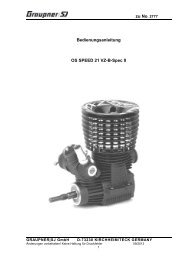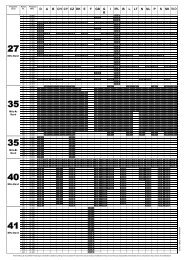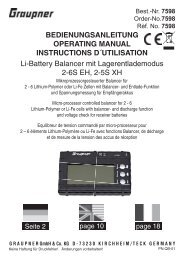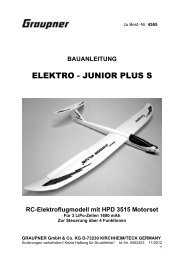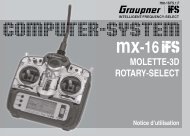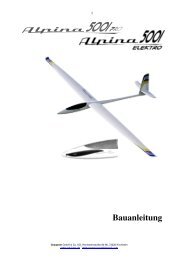Agusta A119 Koala - Graupner
Agusta A119 Koala - Graupner
Agusta A119 Koala - Graupner
You also want an ePaper? Increase the reach of your titles
YUMPU automatically turns print PDFs into web optimized ePapers that Google loves.
<strong>Agusta</strong> <strong>A119</strong> <strong>Koala</strong><br />
Some basic terms used in model helicopter flying<br />
The term "rotary wing machine" indicates that the helicopter’s lift is derived from rotating "wings"<br />
which take the form of rotor blades. As a result, a helicopter does not require a minimum forward<br />
speed in order to fly, i.e. it can hover.<br />
Cyclic pitch<br />
Cyclic pitch variation is used to steer the machine around the roll and pitch axes. Changing cyclic<br />
pitch has the effect of altering blade pitch depending on its position in the circle. The effect<br />
is caused by tilting the swashplate, which then effectively tilts the helicopter in the required direction.<br />
Collective pitch<br />
Collective pitch provides control over vertical movement, i.e. for climb and descent. The pitch of<br />
both rotor blades is altered simultaneously.<br />
Torque compensation<br />
The spinning rotor produces a moment which tends to turn the whole helicopter in the opposite<br />
direction. This effect must be accurately neutralised, and this is the task of the tail rotor. Tail rotor<br />
blade pitch is altered to vary torque compensation. The tail rotor is also used to control the<br />
model around the vertical (yaw) axis.<br />
Hovering<br />
This is the state in which the helicopter flies in a fixed position in the air, without moving in any<br />
direction.<br />
Ground effect<br />
This occurs only when the machine is close to the ground, and it falls off as altitude rises. At an<br />
altitude of about 1 - 1½ times the rotor diameter ground effect is completely absent. Normally<br />
the revolving airflow from the main rotor is able to flow away freely, but in ground effect the air<br />
strikes an obstacle (the ground) and forms an "air cushion". In ground effect a helicopter can lift<br />
a greater weight, but its positional stability is reduced, with the result that it tends to "break<br />
away" in an unpredictable direction.<br />
Climb<br />
Any excess power above that required for hovering can be exploited to make the helicopter<br />
climb. Note that a vertical climb requires more energy than an angled climb which includes forward<br />
motion. For this reason a model with a given amount of motor power will climb more rapidly<br />
at an angle than vertically.<br />
Level flight<br />
A helicopter absorbs least power when flying straight and level at about half-power. If you have<br />
trimmed the machine carefully for a steady hover, it will tend to turn to one side when flown forward.<br />
The reason for this phenomenon is that the rotor blade which is moving forward encounters<br />
an increased airflow caused by the wind, and this increases its upthrust compared with the<br />
blade which is moving downwind, where the same airflow has to be subtracted. The net result is<br />
a lateral inclination of the helicopter.<br />
Descent<br />
If the helicopter’s rotor speed is relatively low and you place the helicopter in a fast vertical descent,<br />
the result can be that insufficient air flows through the rotor. This can cause what is<br />
known as a "turbulent ring stage", when the airflow over the blade airfoil breaks away. The helicopter<br />
is then uncontrollable and will usually crash. A high-speed descent is therefore only possible<br />
if the helicopter is moving forward, or if the rotor is spinning at high speed. For the same<br />
reason care should be exercised when turning the model helicopter downwind after flying into<br />
wind.<br />
Flapping motion of the rotor blades<br />
As we have already seen, the forward-moving blade produces greater upthrust than the trailing<br />
blade. This effect can be minimised by allowing the leading blade to rise and the trailing blade to<br />
fall. The rotor head is fitted with what is known as a flapping hinge to allow this movement, and<br />
16





